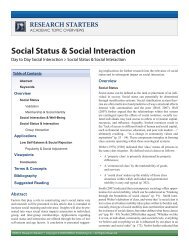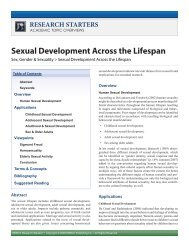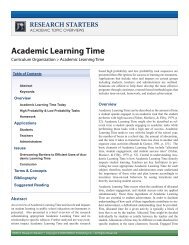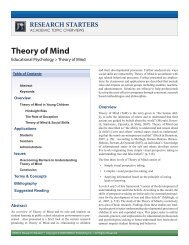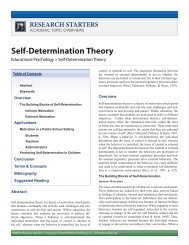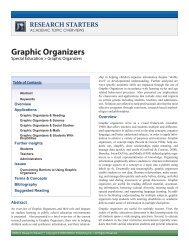Internet Dating - Dswleads.com
Internet Dating - Dswleads.com
Internet Dating - Dswleads.com
You also want an ePaper? Increase the reach of your titles
YUMPU automatically turns print PDFs into web optimized ePapers that Google loves.
RESEARCH STARTERS<br />
ACADEMIC TOPIC OVERVIEWS<br />
<strong>Internet</strong> <strong>Dating</strong><br />
Family & Relationships > <strong>Internet</strong> <strong>Dating</strong><br />
Table of Contents<br />
Abstract<br />
Abstract<br />
Keywords<br />
Overview<br />
Virtual & Physical Reality<br />
Presenting Selves<br />
Advantages of <strong>Internet</strong> <strong>Dating</strong><br />
Applications<br />
The Sociological Impact of <strong>Internet</strong> <strong>Dating</strong><br />
Issues<br />
Conclusion<br />
Social Capital<br />
Adolescents & <strong>Internet</strong> Use<br />
Terms & Concepts<br />
Bibliography<br />
Suggested Reading<br />
This article clarifies issues surrounding the relatively new phenomenon<br />
of <strong>Internet</strong> dating. These issues will be examined in<br />
a review of present literature referencing <strong>Internet</strong> dating. Due<br />
to the fact that the phenomenon of <strong>Internet</strong> dating is new and<br />
has been relatively unexplored in a handful of books and articles<br />
about this topic, potential sociological dimensions of this trend<br />
are not clearly understood. Sociological issues that potentially<br />
impact <strong>Internet</strong> dating include social capital and social support.<br />
These two sociological concepts will be discussed. A conclusion<br />
will be offered that details implications for further research.<br />
Overview<br />
EBSCO Research Starters ® • Copyright © 2009 EBSCO Publishing Inc. • All Rights Reserved<br />
From a historical perspective, “<strong>Internet</strong> dating” can be tracked<br />
back to the mid-1960s when early <strong>com</strong>puters were used to match<br />
individuals by <strong>com</strong>paring data derived from questionnaires. The<br />
technology of using a <strong>com</strong>puter to bring humans together was<br />
promoted as “scientific” and the use of the <strong>com</strong>puter for this purpose<br />
rapidly gained popularity in the United States and Germany<br />
(Hardey, 2002, p571). The rapid expansion of single person<br />
households, especially among professional classes who are most<br />
likely to have <strong>Internet</strong> access in their homes provides a context<br />
for this phenomenon. <strong>Internet</strong> dating itself can be characterized<br />
by a “seamless movement between reading descriptions, writing<br />
responses, and exchanging messages. Compared to the effort,<br />
awkwardness, risks and physical embarrassments often associated<br />
with ‘real world’ dating, the <strong>Internet</strong> can provide some<br />
advantages” (Hardey, 2002, p572).<br />
Moreover, <strong>Internet</strong> dating can be viewed as a potential advancement<br />
of the use of new technologies in the postmodern world.<br />
Marked by constant change, postmodern society now “infiltrates<br />
every sphere of social life” (Morgado, 1996, p44). One such<br />
developing interest to researchers is the way humans create and<br />
re-create their personal identities. An individual’s identity can<br />
be defined as the “cognitive and affective understanding of who<br />
and what we are” (Schouten, 1991, p413). According to the symbolic<br />
interactionist perspective, one part of the understanding of<br />
who or what we are is based on “reflexive evaluation” (Solomon,<br />
1983, p321), which can be defined as the way “we believe<br />
that others see us” (Yurchisin, Watchravesringkan, & McCable,<br />
2005, p735).<br />
Since humanity’s inception, it can be argued that individuals<br />
have modified their behavior to construct and re-construct their<br />
identities in numerous settings. Some of these behavioral contexts<br />
include,<br />
•<br />
•<br />
•<br />
•<br />
Cosmetic surgery (Schouten, 1991),<br />
Skydiving (Celsi, Rose, & Leigh, 1993),<br />
River rafting (Arnould & Price, 1993),<br />
Participation in fantasy-based activities (Kozinets,<br />
2002), and
<strong>Internet</strong> <strong>Dating</strong> Essay by Sharon Link, Ph.D.<br />
Keywords<br />
•<br />
Identity<br />
<strong>Internet</strong> <strong>Dating</strong><br />
Social Capital<br />
Social Support<br />
Symbolic Interactionist Perspective<br />
Natural health food (Thompson & Troester, 2002)<br />
consumption <strong>com</strong>munities (cited in Yurchisin,<br />
Watchravesringkan, & McCable, 2005, p736) .<br />
Additionally, individuals also use their behavior in online contexts<br />
to modify their identities. Research conducted by Schau<br />
and Gilly (2003) demonstrated that consumers utilize personal<br />
website postings to learn about themselves and <strong>com</strong>municate<br />
aspects of their identities to others. Moreover, “if identity is truly<br />
a social phenomenon as intimated by the symbolic interactionist<br />
perspective (Blumer, 1969; Cooley, 1902; Mead, 1934), then<br />
feedback from others would be an important part of the identity<br />
creation and re-creation process”(Yurchisin, Watchravesringkan,<br />
& McCable, 2005, p736). Within the realm of <strong>Internet</strong> dating<br />
additional research should be conducted on ways individuals<br />
choose to re-frame their identities in light of the potentially artificial<br />
environment that dating anonymously might elicit.<br />
Virtual & Physical Reality<br />
Previously conducted research has suggested that virtual reality<br />
is enveloped within physical reality. This research subsequently<br />
pointed out that an individual’s online experience influences their<br />
offline identity” (Yurchisin, Watchravesringkan, & McCable, 2005,<br />
p736). Particularly on <strong>Internet</strong> dating sites, individuals create profiles<br />
of themselves that contain information about their physical<br />
appearance, demographics, and personality characteristics. The use<br />
of these profiles theoretically allows individuals to explore and recreate<br />
their personal identities. The high level of anonymity that<br />
the <strong>Internet</strong> allows as <strong>com</strong>pared to face-to-face encounters offers<br />
individuals the opportunity to showcase elements of their personalities<br />
or self-perceptions they may not ordinarily present in person<br />
(Yurchisin, Watchravesringkan, & McCable, 2005). Furthermore,<br />
the anonymity that <strong>Internet</strong> dating offers may enable individuals<br />
to effectively lie about themselves, and exaggerate specific characteristics<br />
they would like to possess or may have the potential to<br />
possess in the future (Mantovani, 1995; Riva & Galimberti, 1997)<br />
(Yurchisin, Watchravesringkan, & McCable, 2005). Only a few<br />
studies have been conducted in this area, and as the potential for<br />
<strong>Internet</strong> use grows, it is pertinent for researchers to better understand<br />
the impacts of this phenomenon.<br />
Presenting Selves<br />
In order to better understand human perception and <strong>Internet</strong> dating,<br />
it might also be necessary to understand the <strong>com</strong>ponents of iden-<br />
tity, because each of these <strong>com</strong>ponents factor into how individuals<br />
present themselves. Self-conception can be potentially divided into<br />
categories. The first category can be described as “now selves.”<br />
Now selves “describe the self as it is presently is perceived by the<br />
individual.” Another potential category is “possible selves.” Possible<br />
selves are “images of the self that have not yet been realized<br />
but that are hoped for or feared (Markus & Nurius, 1986, p957,<br />
cited in Yurchisin, Watchravesringkan, & McCable, 2005, p737).<br />
Markus and Nurius (1986) demonstrated that possible selves play<br />
an important role in the identity re-creation process. The notion of<br />
possible selves can be used to better understand ways that “cognitive<br />
bridges between the present and the future, specifying how<br />
individuals may change from how they are now to what they will<br />
be<strong>com</strong>e” (p961, cited in Yurchisin, Watchravesringkan, & McCable,<br />
2005, p737). Moreover, Wurf and Markus (1991) predicted<br />
that the re-construction of identity “involves a multi-step process<br />
of development, validation, and redevelopment” (cited in Yurchisin,<br />
Watchravesringkan, & McCable, 2005, p738).<br />
The context of <strong>Internet</strong> dating offers individuals opportunities to<br />
explore their possible selves online and offline and at the same time;<br />
<strong>Internet</strong> dating allows individuals to use a <strong>com</strong>bination of online<br />
and offline behavior and feedback to re-create their identities. In<br />
fact, several dating services encourage participants to “’update’<br />
their profiles to reflect personal changes that have occurred since<br />
they first posted their profiles” (Yurchisin, Watchravesringkan, &<br />
McCable, 2005, p739). Starling (2000) reported: “It’s easy to make<br />
up an identity in cyberspace. People can send you phony pictures<br />
and conjure fascinating lives.” One woman she interviewed indicated,<br />
“You have people out there pretending to be one thing when<br />
they are something else” (p50). Before embarking on the <strong>Internet</strong><br />
dating field, additional research again should be considered into<br />
potential dates and their backgrounds.<br />
Hollander (2004) suggested: ‘Nagging questions remain, in<br />
particular, why such fine human beings must invest so much<br />
time and energy in the search for suitable partners? Are these<br />
self presentations largely wishful fantasies, or exaggerations<br />
of traits possessed” (p75). Further, Hollander (2004) indicated<br />
that “implausible self-presentations are attention getting efforts,<br />
overselling oneself is a response to keen <strong>com</strong>petition for partners<br />
not easy to locate” (p75). More dramatically, Hollander (2004)<br />
indicated that the human need to oversell “reflects the pressures<br />
of a <strong>com</strong>petitive culture and a <strong>com</strong>petitive market place of personal<br />
relationships…especially [among] older women who are<br />
even more often without partners” (p75).<br />
Advantages of <strong>Internet</strong> <strong>Dating</strong><br />
Findings from a recent study indicated that <strong>Internet</strong> dating seems<br />
to be the new approach to dating for multiple reasons: “According<br />
to a New York Times report (Style Section, November 24,<br />
2002) 16.6 million people visited matchmaking Web sites in<br />
September alone … a figure [that] has made <strong>Internet</strong> dating seem<br />
almost stigma-free.…” (Hollander, 2002, p. 69).<br />
This occurred in 2002 - early on in the <strong>Internet</strong> dating phenomenon.<br />
In addition to matchmaking through the internet<br />
EBSCO Research Starters ® • Copyright © 2009 EBSCO Publishing Inc. • All Rights Reserved Page 2
<strong>Internet</strong> <strong>Dating</strong> Essay by Sharon Link, Ph.D.<br />
with specific sites geared toward “dating,” there are also <strong>com</strong>puter<br />
dating services and “personals” which are published in<br />
printed publications that offer new ways to initiate relationships.<br />
Arguably this new phenomenon is relatively unexplored with<br />
ac<strong>com</strong>panying social and personal ramifications that are largely<br />
unknown and not understood (Hollander, 2002). Starling (2000)<br />
indicated that despite the unknown factors,<br />
. . . on-line dating, with all its joys and dangers, has be<strong>com</strong>e<br />
the decade’s hottest way for many groups including<br />
African-American singles to connect through sites specifically<br />
geared to meet the needs of specific social groups<br />
and individuals . . . From on-line personals to cyber-chat<br />
rooms and message boards, professionals are using the<br />
<strong>Internet</strong> to meet new people and find love” (p46).<br />
According to Starling (2000) the <strong>Internet</strong> is giving romance a<br />
different perspective. “Instead of hooking up in nightclubs and<br />
gyms, Black singles also can meet interesting prospects without<br />
leaving home. On the <strong>Internet</strong>, the world be<strong>com</strong>es your meeting<br />
ground” (p48). Individuals can connect through on-line personals,<br />
or they can find their soul mate by chatting in topic rooms<br />
about the Harlem Renaissance or urban renewal. Moreover,<br />
some prospective dates choose to send “virtual flowers and electronic<br />
greeting cards” (p48). One 41-year-old mother of two girls<br />
stated: “I wouldn’t give out my identity or my phone number<br />
right away. Take it slowly and chat with them for a while and<br />
get a sense of their personality and their true self” (p50). Several<br />
individuals indicated the use of reasonable caution as a means of<br />
self-protection.<br />
Hardey (2002) indicated that one of the most important aspects<br />
of <strong>Internet</strong> dating is the wide variety of ways that needs are met.<br />
<strong>Dating</strong> sites dedicated to individuals with disabilities, members<br />
of ethnic <strong>com</strong>munities, individuals seeking casual relationships,<br />
individuals with unusual sexual interests, and sites dedicated<br />
to religious preferences and diet offer a deviation from typical<br />
sites operating within the heterosexual market often advertising<br />
their services in terms of “finding a “soul mate” either leading to<br />
marriage or cohabitation. <strong>Internet</strong> dating itself operates in stark<br />
contrast to traditional approaches to love and marriage” (p574).<br />
According to Bataille (1962), intimacy associated with the kind<br />
of relationship associated with <strong>Internet</strong> dating involves the maintenance<br />
of clear personal boundaries, rather than an absorption<br />
into the other. The consequent vision of this modern intimacy is<br />
“based on talk rather than passion, negotiation rather than <strong>com</strong>mitment,<br />
and the advancement of self rather than the development<br />
of the couple all which suggests that the <strong>Internet</strong> is uniquely<br />
enabled to facilitate this kind of liaison” (Hardey, 2000, p574).<br />
Moreover, once a user has made contact with another member<br />
in an <strong>Internet</strong> dating site, a decision is required as to whether<br />
to enter into an “exchange of messages or to ignore the invitation.<br />
Many users express that this choice allows them a greater<br />
sense of control, which some individuals describe as “liberating”<br />
them from what may be a source of embarrassment off-line” (p<br />
576). Clearly, many advantages have been described as part of<br />
the <strong>Internet</strong> dating phenomenon.<br />
Essentially, the users of <strong>Internet</strong> dating sites are purposed with<br />
the potential of translating virtual relationships into meetings<br />
between flesh and blood individuals (Hardey, 2002, p579). Hollander<br />
(2004) indicated that <strong>com</strong>munication of intimate personal<br />
needs via “terse advertisements may promise to be a more rational<br />
and effective approach to mate-selection that those which used<br />
to prevail in modern Western societies” (p69). <strong>Internet</strong> dating<br />
makes it possible to thwart the frustration of meeting someone<br />
in-person making judgments based on personal impressions,<br />
appearances, and chance. In choosing to date through the <strong>Internet</strong>,<br />
it has been advised that participants should clearly specify<br />
the kind of person they are and the type of person they are seeking.<br />
Moreover, potential <strong>Internet</strong> daters should “make clear that<br />
the centerpiece of [their] recreational interests are Bach cantatas<br />
and vacations in Mediterranean fishing villages rather than<br />
country music and bowling, which produce a better chance of<br />
meeting kindred spirits” (Hollander, 2004, p69).<br />
Applications<br />
The Sociological Impact of <strong>Internet</strong> <strong>Dating</strong><br />
Social Capital<br />
From a sociological perspective, <strong>Internet</strong> dating might be<br />
viewed through two different lenses. First, <strong>Internet</strong> dating could<br />
be viewed through the concept of social capital. Social capital<br />
has been described as a characteristic of the relations between<br />
people. Through trust and reciprocity, social capital enables one<br />
to access the human, social, and cultural resources within a <strong>com</strong>munity<br />
or social network (Coleman, 1988). It can also be defined<br />
as: “Connections among individuals – social networks and<br />
norms of reciprocity and trust that arise from them” (Putnam,<br />
2000, p). Bourdieu described social capital as both a quality and<br />
quantity of relationships; “first, the social relationship itself that<br />
allows individuals to claim access to resources possessed by<br />
their associates, and second, the amount and strength of these<br />
resources” (Portes, 1998, p4). In this understanding, “social capital<br />
is something possessed by individuals that gains its strength<br />
in the aggregate of social networks” (Seamen & Sweeting, 2004,<br />
p174). Social capital can also be viewed as having the potential<br />
to enhance the health of individuals and <strong>com</strong>munities (Kawachi<br />
& Berkman, 2000). Multiple implications regarding social<br />
capital and <strong>Internet</strong> dating could be inferred from this definition,<br />
and further research in this area should be conducted in order to<br />
understand potential impacts.<br />
Beaudoin and Tau (2007) indicated that approximately 28% use<br />
online support groups related to medical conditions and personal<br />
problems. For example, 58% of patients with cancer use the<br />
<strong>Internet</strong> as a source of cancer information and support. This type<br />
of <strong>Internet</strong> use leads to “increases in social support, <strong>com</strong>munity,<br />
and coping and decreases in loneliness, depression, and anxiety”<br />
(p587). According to ComScore Media Metrix, over “19% of<br />
Web surfers visited a dating site last October” (cited in Goldberg,<br />
2003, p109). In the case of positive out<strong>com</strong>es from <strong>Internet</strong><br />
encounters, “potential benefits and increases of social capital<br />
were found. In the case of online support groups, social capital<br />
EBSCO Research Starters ® • Copyright © 2009 EBSCO Publishing Inc. • All Rights Reserved Page 3
<strong>Internet</strong> <strong>Dating</strong> Essay by Sharon Link, Ph.D.<br />
and social support increased, which led to subsequent positive<br />
health out<strong>com</strong>es” (Beaudoin & Tao, 2007, p589). Certainly<br />
then, it could be concluded that in the case of <strong>Internet</strong> dating, in<br />
order for social capital to be an out<strong>com</strong>e, experiences should be<br />
positive, supportive, and authentic. Based on the potential positive<br />
out<strong>com</strong>e of increased social capital, increased social support<br />
may also result. Social support “involves advice and emotional<br />
reinforcement [and] is a behavioral out<strong>com</strong>e of social capital”<br />
(p589). Results from an additional study suggested that while the<br />
<strong>Internet</strong> may suggest a socially displacing effect, “it is also likely<br />
a source of new, qualitatively different social capital” (Williams,<br />
2007, p398).<br />
Adolescents & <strong>Internet</strong> Use<br />
Another significant application of the <strong>Internet</strong> is the impact on<br />
adolescents. Adolescents use the <strong>Internet</strong> for multiple purposes,<br />
but one of the biggest applications is its use for <strong>com</strong>munication.<br />
The applications adolescents use to further social relationships<br />
include e-mail, instant messaging, blogs, and chat rooms (Boneva,<br />
Quinn, Kraut, Kiesler, & Shklovski, 2006; Craig, 2003; Gross,<br />
et al, 2002; Schiano, Chen, Ginsberg, Gretarsdottir, Huddleston,<br />
& Isaacs, 2002). In a national survey of adolescents, participants<br />
revealed that over 25% of <strong>Internet</strong> users had formed online friendships<br />
and 14% formed close friendships or romantic relationships<br />
(Wolak, Mitchell, & Finkelhor, 2002, p445). Research has further<br />
suggested that adolescent use of the <strong>Internet</strong> is associated with<br />
declines in well-being (Kraut et al., 1998), and ac<strong>com</strong>panying<br />
weaker social ties (Kraut et al., 1998; Sanders, Field, Diego, &<br />
Kaplan, 2000). Regular <strong>Internet</strong> users reported lower levels of<br />
attachment to close friends (Mesch, 2001), and negative perceptions<br />
about the quality of family relationships (Mesch, 2003).<br />
These views are directly opposite to other views regarding positively<br />
reported social benefits. However, a study of adolescents’<br />
friendship networks revealed that the teens who had stable and<br />
active networks reported less loneliness, better moods, and more<br />
support from their friends (Degirmencioglu, 1995). Perhaps then,<br />
if similar applications could be made regarding <strong>Internet</strong> dating it<br />
could be true that <strong>Internet</strong> users with highly cohesive and interconnected<br />
friendship networks may benefit more from <strong>Internet</strong> dating<br />
than those who do not have a strong base of social support.<br />
Issues<br />
The issues with <strong>Internet</strong> dating are profound and largely unexplored.<br />
It is difficult to make guesses regarding potential benefits, negative<br />
attributes, or other impacts, because more research needs to be<br />
done in order to understand the phenomenon of <strong>Internet</strong> dating.<br />
These phenomenon seem to readily occur and can be linked to<br />
the potential for creating and re-creating identity, which was<br />
earlier indicated as part of the phenomenon of <strong>Internet</strong> dating.<br />
Yurchisin, Watchravesringkan, and McCabe (2005) indicated<br />
that individuals often used their profiles for “identity exploration<br />
and re-creation purposes,” and many mentioned that they<br />
would rather try out “new features of their identities on the <strong>Internet</strong><br />
as opposed to in the real world because the <strong>Internet</strong> afforded<br />
them some degree of anonymity that the real world did not.” As<br />
a result, individuals indicated that “the anonymity of the <strong>Internet</strong><br />
permitted each informant to include a <strong>com</strong>bination of both now<br />
and possible selves in one profile” (p742). It is perhaps likely<br />
based on this information that caution is advised before fully<br />
engaging in the process of <strong>Internet</strong> dating.<br />
Cost is another issue pertaining to <strong>Internet</strong> dating. From a pragmatic<br />
perspective, Metz (2004) indicated that eHarmony® ranks<br />
first in attracting new dollars. One of the main reasons is that<br />
eHarmony® draws large numbers of users because it advertises<br />
heavily on both radio and television broadcasts. It also charges<br />
a premium for its “scientifically proven” psychological profiling<br />
to make matches (p92). Goldberg (2004) indicated that most<br />
people sign up for a month at a time on a dating site. However,<br />
given that average paying user stays with a dating site for four<br />
months, users should consider paying up front for three months<br />
at a time, and to cancel the membership rather than risk being<br />
billed monthly (p110). Certainly, monetary consideration is<br />
another factor in selecting the sites for <strong>Internet</strong> dating.<br />
Conclusion<br />
In order to understand the long-term impacts of <strong>Internet</strong> dating,<br />
sociologists should consider more studies investigating the multiple<br />
aspects of this phenomenon. Given that the phenomenon of<br />
<strong>Internet</strong> dating has only occurred for such a short period of time,<br />
it is hard to know whether the phenomenon is positive or negative<br />
and its longitudinal prospects. As additional studies are conducted<br />
regarding this phenomenon, it will be interesting to determine<br />
gender consequences, impacts on potential offspring resulting from<br />
an <strong>Internet</strong> dating union, and socioeconomic results as the <strong>Internet</strong><br />
has the potential for breaking through past social and socioeconomic<br />
barriers between individuals and groups in differing social<br />
groups. Research should be considered in all of these areas.<br />
Terms & Concepts<br />
Identity: Identity can be defined as the “cognitive and affective<br />
understanding of who and what we are.”<br />
<strong>Internet</strong> <strong>Dating</strong>: <strong>Internet</strong> dating can be described as a process<br />
in which individuals create profiles of themselves that contain<br />
information about their physical appearance, demographics, and<br />
personality characteristics for the purpose of meeting, dating,<br />
and potentially marrying or entering into relationship with potentially<br />
suitable mates.<br />
Social Capital: Social Capital can be described as connections<br />
among individuals – social networks and norms of reciprocity<br />
and trust that arise from them.<br />
Social Support: Social support “involves advice and emotional<br />
reinforcement [and] is a behavioral out<strong>com</strong>e of social capital.”<br />
Symbolic Interactionist Perspective: According to the<br />
symbolic interactionist perspective, one part of the understanding<br />
of who or what we are is based on “reflexive evaluation,”<br />
which can be defined as the way we believe that others see us.<br />
EBSCO Research Starters ® • Copyright © 2009 EBSCO Publishing Inc. • All Rights Reserved Page 4
<strong>Internet</strong> <strong>Dating</strong> Essay by Sharon Link, Ph.D.<br />
Bibliography<br />
Arnould, E. J., & Price, L. L. (1993). River magic: Extraordinary<br />
experience and the extended service encounter. Journal of<br />
Consumer Research, 20 (June), 24-45.<br />
Baigh, J. A., McKenna, K. Y. A., & Fitzsimons, G. M. (2002).<br />
Can you see the real me? Activation and expression of the<br />
‘true self’ on the <strong>Internet</strong>. Journal of Social Issues, 58<br />
(1), 33-48. Retrieved August 3, 2008 from EBSCO online<br />
database Academic Search Premier: http://search.ebscohost.<strong>com</strong>/login.aspx?direct=true&db=a9h&AN=6194722<br />
&site=ehost-live<br />
Baudrillard, J. (1988). The consumer society. In M. Poster<br />
(Ed.), Jean Baudrillard: selected writings, (pp. 29-56).<br />
Cambridge, UK: Polity Press.<br />
Beaudoin, C. E. & Tau, C. (2007). Benefiting from social capital<br />
in online support groups: An empirical study of cancer<br />
patients. Cyber Psychology & Behavior, 10, 587 – 590.<br />
Retrieved August 3, 2008 from EBSCO online database<br />
Academic Search Premier: http://search.ebscohost.<strong>com</strong>/<br />
login.aspx?direct=true&db=a9h&AN=26271130&site=eh<br />
ost-live<br />
Blumer, H. (1969). Symbolic interactionism: Perspective and<br />
method. Englewood Cliffs, NJ: Prentice Hall.<br />
Boneva, B. S., Quinn, A., Kraut, R. E., Kiesler, S., &<br />
Shklovski, I. (2006). Teenage <strong>com</strong>munication in the<br />
Instant Messaging era. In R. Kraut, M. Brynin, &<br />
S. Kiesler (Eds.), Information technology at home.<br />
New York: Oxford University Press. http://www-2.<br />
cs.cmu.edu/~kraut/RKraut.site.files/articles/Boneva04-<br />
TeenCommunicationInIMEra.pdf<br />
Celsi, R. L., Rose, R. L., & Leigh, T. W. (1993). An exploration<br />
of high-risk leisure consumption through skydiving.<br />
Journal of Consumer Research, 20 (June), 1-23.<br />
Coleman, J.S. (1988). Social capital in the creation of human<br />
capital. American Journal of Sociology, 94, S95–S121.<br />
Cooley, C. H. (1902). Human nature and the social order. New<br />
York: Charles Scribner’s Sons.<br />
Craig, D. (2003). Instant messaging: The language of youth literacy.<br />
Stanford University Boothe Prize essay. Retrieved<br />
August 3, 2008 from Stanford University. http://pwr.<br />
stanford.edu/publications/Boothe_0203/PWR%20Boothe-<br />
Craig.pdf<br />
Degirmencioglu, S. M. (1995). Changes in adolescents’ friendship<br />
networks: Do they matter? Dissertation Abstracts<br />
International, 56.<br />
Firat, A. F. (1994). Gender and consumption: Transcending the<br />
feminine? In J. A. Costa (Ed.), Gender issues and consumer<br />
behavior. Thousand Oaks, CA: Sage Publications.<br />
Goldberg, S. (2003). Oh. What a tangled web. Kiplingers<br />
Personal Finance, 57(3), 108-110. Retrieved August 3,<br />
2008 from EBSCO online database Academic Search<br />
Premier: http://search.ebscohost.<strong>com</strong>/login.aspx?direct=tr<br />
ue&db=aph&AN=8769246&site=ehost-live<br />
Gross, E. F., Juvonen, J., & Gable, S. E. (2002). <strong>Internet</strong> use<br />
and well-being in adolescence: The social function of<br />
instant messages. Journal of Social Issues, 58(1), 75-90.<br />
Retrieved August 3, 2008 from EBSCO online database<br />
Academic Search Premier: http://search.ebscohost.<strong>com</strong>/<br />
login.aspx?direct=true&db=a9h&AN=6194720&site=eho<br />
st-live<br />
Hall, R., Ogen, P. L., & Hill, C. (1999). Living alone: Evidence<br />
from England and Wales and France for the last 2 decades.<br />
In McRae, S. (ed). Changing Britain, Families and<br />
Households in the 1990s. Oxford: Oxford University Press.<br />
Hardey, M. (2002). Life beyond the screen: Embodiment and<br />
identity through the <strong>Internet</strong>. The Sociological Review,<br />
50(4), 570-585. Retrieved August 3, 2008 from EBSCO<br />
online database Academic Search Premier: http://search.<br />
ebscohost.<strong>com</strong>/login.aspx?direct=true&db=a9h&AN=890<br />
7762&site=ehost-live<br />
Hollander, P. (2004). The counterculture of the heart. Society,<br />
Jan/Feb, 69 – 77. Retrieved August 3, 2008 from EBSCO<br />
online database Academic Search Premier: http://search.<br />
ebscohost.<strong>com</strong>/login.aspx?direct=true&db=a9h&AN=186<br />
73714&site=ehost-live<br />
Kawachi, I. &c Berkman, L. (2000). “Social cohesion, social<br />
capital and health”. In L.Berkman & I. Kawachi (eds.).<br />
Social epidemiology. New York, Oxford University Press.<br />
Kozinets, R. V. (2002). Can consumers escape the market?<br />
Emancipatory illuminations from Burning Man. Journal<br />
of Consumer Research, 28 (June), 67-88.<br />
Loader, H. (1998). (ed.) Cyberspace divide. London Routledge.<br />
Mantovani, G. (1995).Virtual reality as a <strong>com</strong>munication environment:<br />
Consensual hallucination, fiction, and possible<br />
selves. Human Relations, 48(6), 669-683.<br />
Markus, H., & Nurius, P. (1986). Possible selves. American<br />
Psychologist, 41(9), 954-969.<br />
McKenna, K. Y. A., & Bargh, J. A. (2000). Plan 9 from cyberspace:<br />
The implications of the <strong>Internet</strong> for personality<br />
and social psychology. Personality and Social Psychology<br />
Review, 4(1), 57-75. Retrieved August 3, 2008 from<br />
EBSCO Research Starters ® • Copyright © 2009 EBSCO Publishing Inc. • All Rights Reserved Page 5
<strong>Internet</strong> <strong>Dating</strong> Essay by Sharon Link, Ph.D.<br />
EBSCO online database Academic Search Premier: http://<br />
search.ebscohost.<strong>com</strong>/login.aspx?direct=true&db=a9h&A<br />
N=3176644&site=ehost-live<br />
McKenna, K. Y. A., Green, A. S., & Gleason, M. E. J. (2002).<br />
Relationship formation on the <strong>Internet</strong>: What’s the big<br />
attraction? Journal of Social Issues, 58(1), 9-31. Retrieved<br />
August 3, 2008 from EBSCO online database Academic<br />
Search Premier: http://search.ebscohost.<strong>com</strong>/login.aspx?di<br />
rect=true&db=a9h&AN=3176644&site=ehost-live<br />
Mead, G. H. (1934). Mind, self, and society. Chicago: The<br />
University of Chicago Press.<br />
Mesch, G. S. (2001). Social relationships and <strong>Internet</strong> use<br />
among adolescents in Israel. Social Science Quarterly,<br />
82(2), 329-339. Retrieved August 3, 2008 from EBSCO<br />
online database Academic Search Premier: http://search.<br />
ebscohost.<strong>com</strong>/login.aspx?direct=true&db=a9h&AN=658<br />
3130&site=ehost-live<br />
Mesch, G. S. (2003). The family and the <strong>Internet</strong>: The<br />
Israeli case. Social Science Quarterly, 84(4), 1039-1050.<br />
Retrieved August 3, 2008 from EBSCO online database<br />
Academic Search Premier: http://search.ebscohost.<strong>com</strong>/<br />
login.aspx?direct=true&db=a9h&AN=11358701&site=eh<br />
ost-live<br />
Metz, C. (2004). Lucky in love: Java and open-source tools<br />
are big hits on the eHarmony dating scene. PC Magazine,<br />
23(17), 92. Retrieved August 3, 2008 from EBSCO online<br />
database Academic Search Premier: http://search.ebscohost.<strong>com</strong>/login.aspx?direct=true&db=aph&AN=14488850<br />
&site=ehost-live<br />
Morgado, M. A. (1996). Coming to terms with postmodern:<br />
Theories and concepts of contemporary culture and their<br />
implications for apparel scholars. Clothing and Textiles<br />
Research Journal, 14(1), 41-53.<br />
Muniz, A. M., Jr., & O’Guinn, T. C. (2001). Brand <strong>com</strong>munity.<br />
Journal of Consumer Research, 27(4), 412-432.<br />
Portes, A. (1998). Social capital: Its origins and applications in<br />
modern sociology. Annual Review of Sociology, 24, 1–24.<br />
Retrieved July 31, 2008 from EBSCO online database<br />
Academic Search Premier: http://search.ebscohost.<strong>com</strong>/<br />
login.aspx?direct=true&db=a9h&AN=1056932&site=eho<br />
st-live<br />
Putnam, R. (2000). Bowling alone: The collapse and revival of<br />
American <strong>com</strong>munity. New York: Simon and Schuster.<br />
Riva, G., & Galimberti, C. (1997). The psychology of cyberspace:<br />
A socio-cognitive framework to <strong>com</strong>puter-mediated<br />
<strong>com</strong>munication. New Ideas in Psychology, 15(2),<br />
141-158.<br />
Sanders, C. E., Field, T. M., Diego, M., & Kaplan, M. (2000).<br />
The relationship of <strong>Internet</strong> use to depression and social<br />
isolation among adolescents. Adolescence, 35, 237-241.<br />
Retrieved August 3, 2008 from EBSCO online database<br />
Academic Search Premier: http://search.ebscohost.<strong>com</strong>/<br />
login.aspx?direct=true&db=a9h&AN=3600931&site=eho<br />
st-live<br />
Schau, H. J., & Gilly, M. C. (2003). We are what we post?<br />
Self-presentation in personal web space. Journal of<br />
Consumer Research, 30(3), 385-404.<br />
Schiano, D., Chen, C, Ginsberg, J., Gretarsdottir, U.,<br />
Huddleston, M., & Isaacs, E. (2002). Teen use of messaging<br />
media. In CHI 2002, Minneapolis, MN, 594-595.<br />
Schouten, J. W. (1991). Selves in transition: Symbolic consumption<br />
in personal rites of passage and identity reconstruction.<br />
Journal of Consumer Research, 17 (March),<br />
412-425.<br />
Seaman P. & Sweeting, H. (2004). Assisting young people’s<br />
access to social capital in contemporary families: A<br />
qualitative study. Journal of Youth Studies, 7(2), 173–190.<br />
Retrieved July 31, 2008 from EBSCO online database<br />
Academic Search Premier: http://search.ebscohost.<strong>com</strong>/<br />
login.aspx?direct=true&db=a9h&AN=13532221&site=eh<br />
ost-live<br />
Solomon, M. R, (1983). The role of products as social stimuli:<br />
A symbolic interactionism perspective. Journal of<br />
Consumer Research, 10(3), 319-329.<br />
Starling, K. (2000). The joys and dangers of love on the<br />
<strong>Internet</strong>. Ebony, 55(4), 46 – 52. Retrieved August 3, 2008<br />
from EBSCO online database Academic Search Premier:<br />
http://search.ebscohost.<strong>com</strong>/login.aspx?direct=true&db=a<br />
9h&AN=2654328&site=ehost-live<br />
Tambyah, S. K. (1996). Life on the net: The re-construction<br />
of self and <strong>com</strong>munity. In K. Cordnan & J. G. Lynch, Jr.<br />
(Eds.). Advances in consumer research, 23, 172-177).<br />
Provo, UT: Association for Consumer Research.<br />
Thompson, C. J., & Troester, M. (2002). Consumer value systems<br />
in the age of postmodern fragmentation: The case<br />
of the natural health microculture. Journal of Consumer<br />
Research, 28 (March), 550-571.<br />
Turkle, S. (1995). Life on the screen: Identity in the age of the<br />
<strong>Internet</strong>. New York: Simon & Schuster.<br />
Williams, D. (2007). The impact of time online: Social capital<br />
and cyberbalkanization. Cyber Psychology & Behavior,<br />
10(3), 398 – 406. Retrieved August 3, 2008 from EBSCO<br />
online database Academic Search Premier: http://search.<br />
ebscohost.<strong>com</strong>/login.aspx?direct=true&db=a9h&AN=255<br />
36577&site=ehost-live<br />
EBSCO Research Starters ® • Copyright © 2009 EBSCO Publishing Inc. • All Rights Reserved Page 6
<strong>Internet</strong> <strong>Dating</strong> Essay by Sharon Link, Ph.D.<br />
Wolak, J., Mitchell, K. J., & Finkelhor, D. (2003). Close<br />
online relationships in a national sample of adolescents.<br />
Adolescence, 37, 441-455. Retrieved August 3, 2008 from<br />
EBSCO online database Academic Search Premier: http://<br />
search.ebscohost.<strong>com</strong>/login.aspx?direct=true&db=a9h&A<br />
N=8520052&site=ehost-live<br />
Wurf, E., & Markus, H. (1991). Possible selves and the psychology<br />
of personal growth. In D. J. Ozer, J. M. Healy,<br />
& A. J. Stewart (Eds.), Perspectives on personality, 3,<br />
39-62), London: Jessica Kingsley.<br />
Yurchisin, J., Watchraveringkan, K., & Brown-McCabe, D.<br />
(2005). An exploration of identity re-creation in the context<br />
of internet dating. Social Behavior and Personality,<br />
33(8), 735 – 750. Retrieved August 3, 2008 from EBSCO<br />
online database Academic Search Premier: http://search.<br />
ebscohost.<strong>com</strong>/login.aspx?direct=true&db=aph&AN=191<br />
64541&site=ehost-live<br />
Essay by Sharon Link, Ph.D.<br />
Suggested Reading<br />
Gollwitzer, P. M. (1986). Striving for specific identities: The<br />
social reality of self-symbolizing. In R. Baumeister (Ed.),<br />
Public self and private self (pp. 143–159). New York:<br />
Springer.<br />
Leary, M. R., & Kowalski, R. M. (1995). Social anxiety. New<br />
York: Guilford.<br />
Rheingold, H. (1993). The virtual <strong>com</strong>munity: Homesteading<br />
on the electronic frontier. New York: Harper & Row.<br />
Slouka, M. (1995). War of the worlds: Cyberspace and the<br />
high-tech assault on reality. New York: Basic.<br />
Turkle, S. (1985). The second self. New York: Simon &<br />
Schuster<br />
Dr. Sharon Link is an educator, presenter, and mother of a child with autism. She has worked extensively in public education and<br />
has researched education and its relationship to autism disorders and other disabilities for the last ten years. Dr. Link currently is the<br />
Executive Director for Autism Disorders Leadership Center, a non-profit research center and is co-founder of Asperger Interventions &<br />
Support, Inc. a professional development center. Both organizations are education and research centers seeking to improve education by<br />
creating a system of diversity and inclusion in America’s schools. To learn more, visit: Asperger Help at http://aspergerhelp.net.<br />
EBSCO Research Starters ® • Copyright © 2009 EBSCO Publishing Inc. • All Rights Reserved Page 7




